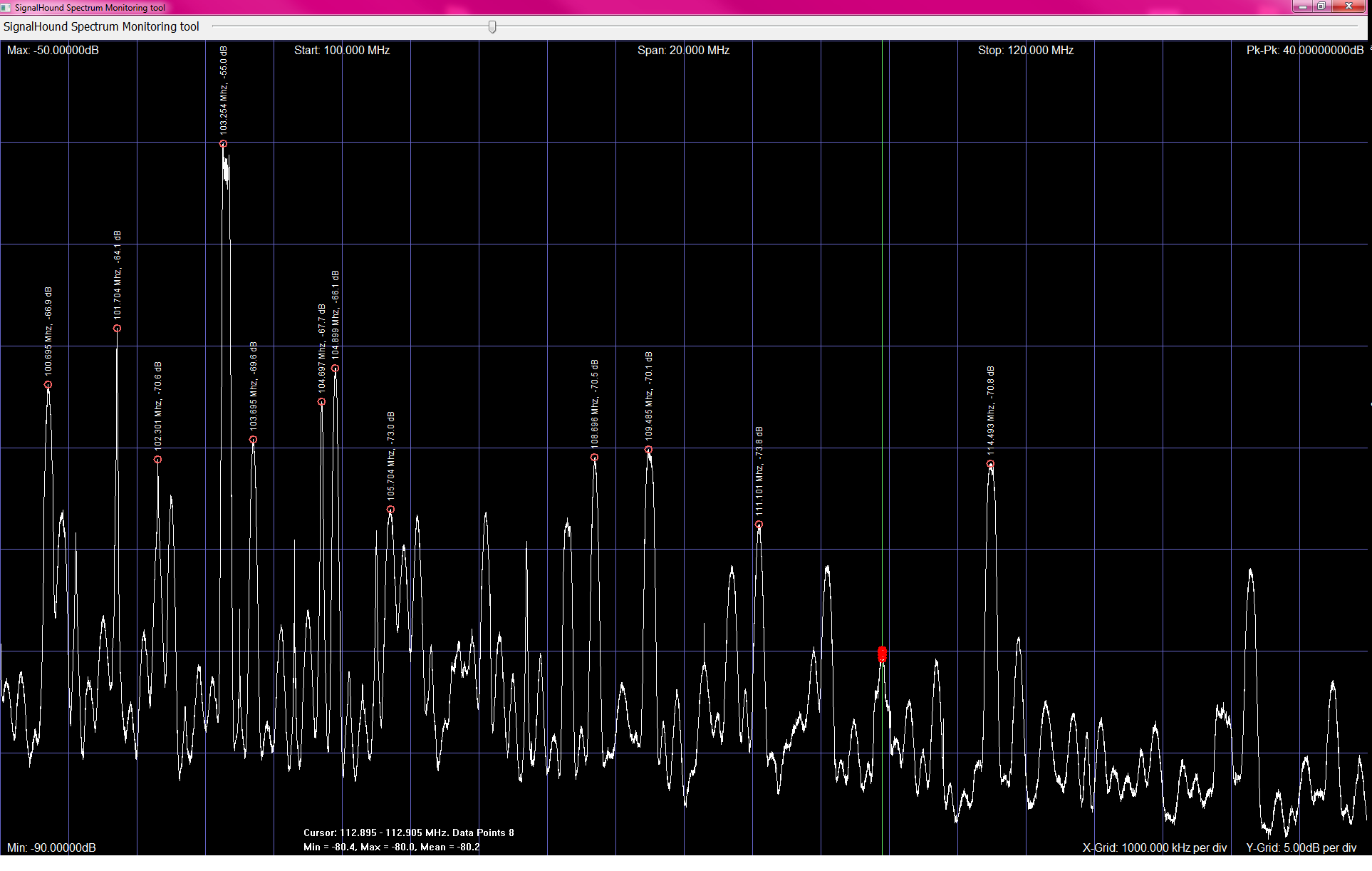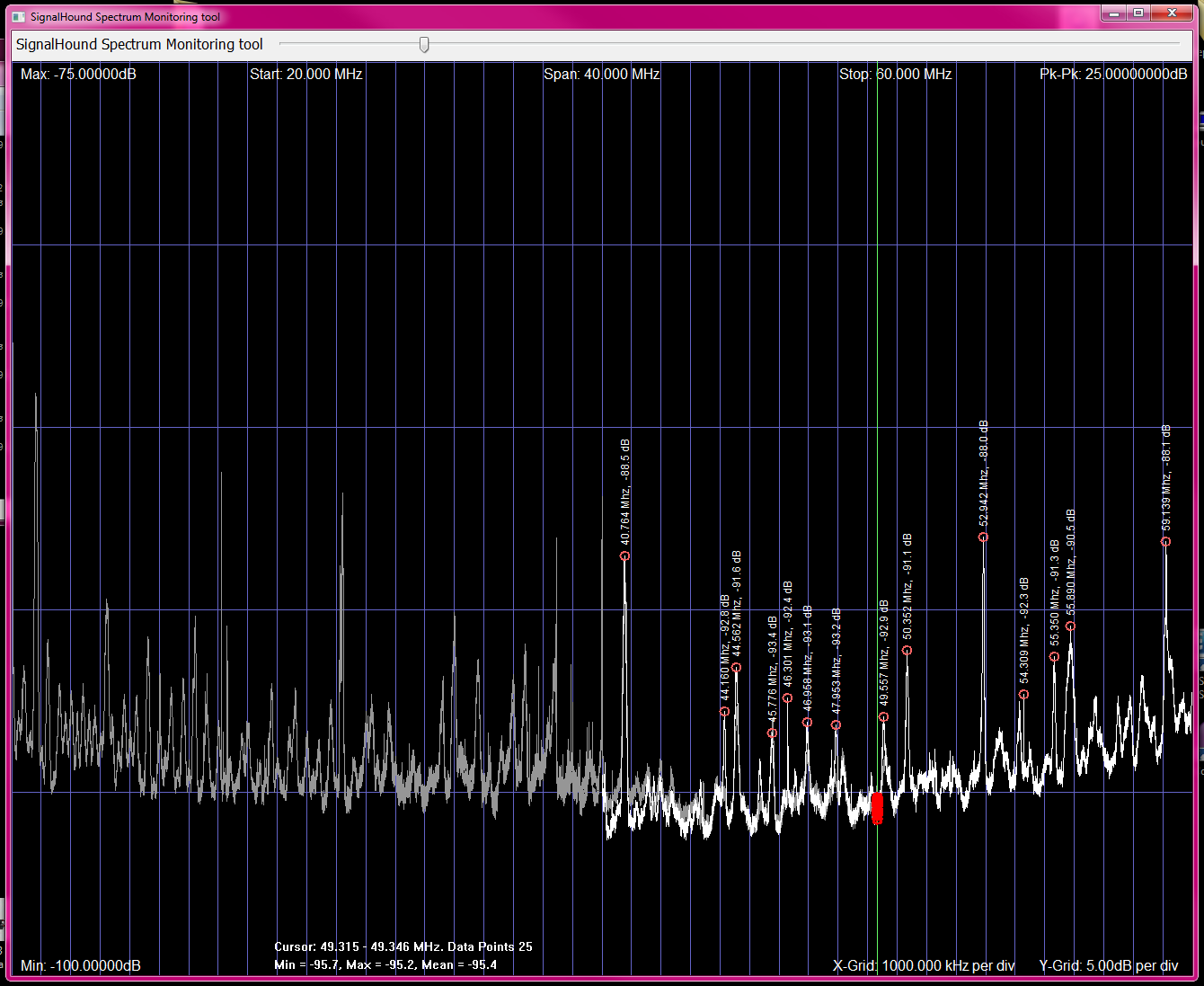A python wrapper for the Test Equipment Plus SignalHound series of spectrum analyzers.
The primary file is "SignalHound.py". It defines one class, "SignalHound()", that currently can only open the first signal-hound analyser it finds.
Predominantly, all C API errors should be caught, and re-raised as python exceptions with helpful error messages.
Also, there is some error checking for function parameters. I should probably
go through and add {library}.{function}.restype = {something} type hints to
all the function calls, but I think the fact that I'm explicitly casting all
parameters to ctypes values should somewhat ameliorate that need.
At the moment, the one function that takes a callback ( (Raw sweep mode is
depreciated.)bbStartRawSweepLoop)
properly wraps a passed python function, so it gets called via the C callback,
though it still relys on the user decoding the C function call arguments. I
want to do something about that in the near future.
Currently, I can only test with a BB60C, as that is the only unit I have on-hand. It should work with a BB60A without too much trouble, though (it has provisions for it, and I did my initial dev work with a BB60A. I just upgraded later).
Installation:
python setup.py install
This will drop the bb_api.dll dll in your {python-dir}/DLLs/ directory, as
well as install the SignalHound wrapper.
The primary API contained in the SignalHound/__init__.py file.
bb_api_h.py is a transliteration of the bb_api.h file from the C api, and
primarily defines most of the configuration constants used for controlling
the SignalHound. It contains no executable code.
tests.py contains a number of different hardware test facilities.
tests.py is a good proof-of-concept demo. It's currently messy, but it shows
the capabilities of both python and the SignalHound.
python tests.py radio {frequency-in-hz}will do real-time software decoding and playback of FM radio.python tests.py raw-pipewill log the full-rate 160 MBPS data-stream to disk in real-time (requires a SSD).python tests.py callbackdemonstrates the ability to have the C api callback into pure python code
Utilities:
python tests.py statusprints the connected hardware version, serial,- firmware version, and API version, as well as querying the hardware
- diagnostics values.
python tests.py resettriggers a firmware-level reset of the hardware,- equivalent to disconnecting and reconnecting the USB interface.
While tests.py is functional, it's very messily written. Cleanup is needed.
The API files themselves are fairly coherent, however.
The ability to configure some of the test-modes is also a good idea, though it
also needs to be implemented.
spectraLog.py is the script that is why I wrote the API in the first place.
It does long-duration (days!) spectrum logging for site-survey purposes and
analysis. It is a fully-multi-process tool that does on-the-fly averaging of
the incoming data-stream to reduce disk load.
Note: spectraLog.py is aggressively multi-process, and you must stop it
by typing "q" + [enter], to properly signal all the running processes to
exit. A typical Ctrl+C will just signal the process attached to the console to
exit, but due to a quirk in the multiprocessing module, I cannot properly
install a signal handler to catch the Ctrl+C in a proper manner. Yes, this is
irritating. I will probably look at solving it eventually.
All the behaviour of spectraLog.py is controlled by the configuration
variables in settings.py in the SpectraLogger directory. This file also
contains fairly extensive documentation, and should be fairly self-explanitory.
The spectraLog.py tool exposes most of the functionality of the signalhound,
though most of the raw-data modes are either not supported or poorly
(or entirely un)tested.
Currently, there is also a prototype visualization tool as well (main.py in
the RealtimeSpectraLogTool directory):
The visualization tool connects to a running acquisition session, and retreives scans from the currently running acquisition. The advantage of this is that it can connect and disconnect from a running acquisition, all without interrupting the actual data-logging in the acquisition.
Also, the current interface for the visualization and acquisition scripts is
over TCP, so you can connect to a running acquisition on one computer, and view
the plots of the data on a different computer
(python main.py {computer running acq's IP}).
The visualization tool also generates some simple statistics for the acquired data, as well as automatically highlighting all the peaks above a certain threshold in the display (adjustable with the slider at the top of the window).
Lastly, it features a mouse-cursor that gives the minimum, maximum, and mean value of the data under the mouse cursor in realtime, as well as highlighting the data-points in the column that is mouse-overed (each column is 1 pixel, and given the fact that displays are typically 1000-3000 pixels wide, and the sweeps are generally ~16Kitems, each pixel "column" has >10 items). The cursor is the vertical green line in the screenshots.
Each datapoint is highlighted with a red circle.
The visualization also has extensions to support the custom pseudo-sweeping
mode that is implemented in internalSweepSpectraAcqThread.py. This is a
special acquisition mode that is implemented for some of the astrophysics
data-acquisition we want to do. Basically, it runs the hardware in realtime
mode, but every n scans in realtime mode, it halts the acquisition, changes
the frequency, and starts acquiring in realtime at the new frequency. It has
configurable overlap for each frequency step. as well as configurable frequency
and span.
In the stepped mode, only the latest data row is active with regard to the cursor, though the entire swept range is displayed. The older data is the slightly darker grey colour.
The special pseudo-sweeping mode is specifically to allow much greater control
and insight into the integration time of the SignalHound. One of the issues
with the SignalHound's internal sweeping mode is the actual percentage of the
time the system is actually acquiring data is not well known. In the
realtime mode, the observation time is 100%, so it's clearly established,
but the bandwidth is limited to 20 Mhz.
By stepping the system through frequencies at a low rate (typically > 10 seconds per frequency), we can achieve a observation time efficiency of nearly 100% / number of observation bands, which allows us to rigidly quantify actual signal strength when integrating data over many hours.
Since the signals we're interested in are astrophysical phenomenon, and we expect to need many hours or days of integration time to resolve the signals from both the system and physical noise, being able to define precisely the actual duration each frequency was acquired for is vital.
The SignalHound does take some time to re-tune the frontend when stepping frequencies (~1 second), which is unfortunate, but the loss here can simply be offset by integrating at each frequency for a longer period of time.
Unfortunately, the SignalHound API does not allow re-tuning of the frontend
while acquiring in realtime mode. Interestingly enough, you can call the configureCenterSpan function on a running acquisition, and it returns with
a "succeeded" call status, but appears to do nothing.
Dependencies:
SignalHound.py requires:
- Numpy
- Windows or Linux Python 2.7.* install (cygwin's python install does not
have a functional
ctypes.wintypes)
tests.py additionally requires:
pyaudio(for the "radio" test only)
The SpectraLogger\main.py long-term spectra logging tool additionally requires:
- h5py (For writing log files)
- colorama (better console output)
The RealtimeSpectraLogTool\main.py also requires:
- wxPython >= 2.9
-
- "THE BEER-WARE LICENSE":
- Connor Wolf wolf@imaginaryindustries.com wrote this file. As long as you retain
- this notice you can do whatever you want with this stuff. If we meet some day,
- and you think this stuff is worth it, you can buy me a beer in return.
- (Only I don't drink, so a soda will do). Connor
- Also, support the Signal-Hound devs. Their hardware is pretty damn awesome.
-

